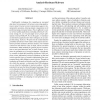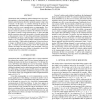15 search results - page 2 / 3 » Hiding Virtualization from Attackers and Malware |
NDSS
2008
IEEE
14 years 1 months ago
2008
IEEE
Traditionally, techniques for computing on encrypted data have been proposed with privacy preserving applications in mind. Several current cryptosystems support a homomorphic oper...
CCS
2007
ACM
14 years 1 months ago
2007
ACM
An alarming trend in malware attacks is that they are armed with stealthy techniques to detect, evade, and subvert malware detection facilities of the victim. On the defensive sid...
RAID
2010
Springer
13 years 5 months ago
2010
Springer
Abstract. Software flaws in applications such as a browser may be exploited by attackers to launch drive-by-download (DBD), which has become the major vector of malware infection....
ICIP
2004
IEEE
14 years 8 months ago
2004
IEEE
Quantization index modulation (QIM) techniques have been gaining popularity in the data hiding community because of their robustness and information-theoretic optimality against a...
IJDE
2006
13 years 7 months ago
2006
Rootkits are malicious programs that silently subvert an operating system to hide an intruder's activities. Although there are a number of tools designed to detect rootkits, ...


